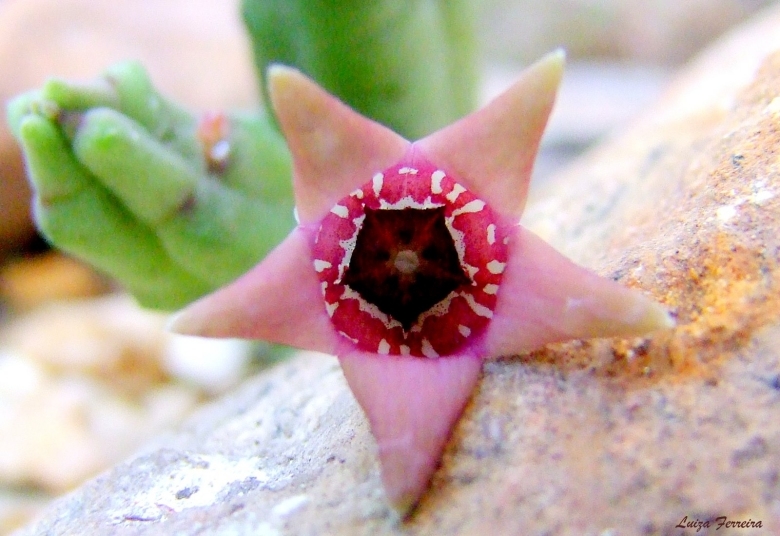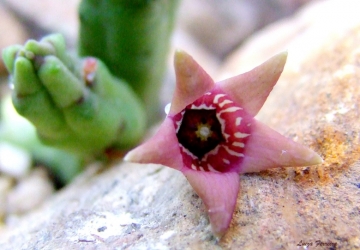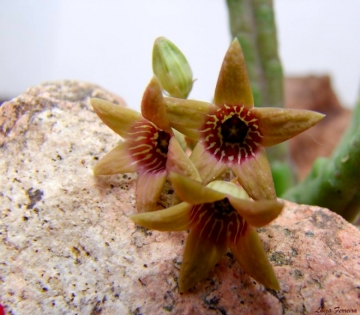Accepted Scientific Name: Tromotriche umdausensis (Nel) Bruyns
S. African J. Bot. 61(4): 207, f. 30 1995

Tridentea umdausensis (Tromotriche umdausensis) Photo by: Luiza Ferreira
Origin and Habitat: Western Cape Province (Little Namaqualand-Richtersvelde). Tromotriche umdausensis was discovered by H. Herre in 1929 at Umdaus, a lonely area in the Richtersveld.
Altitude range: 600 - 1000 metres above sea level.
Habitat and ecology: This species grow on rock crevices receiving some shade from the mid-day sun.
Synonyms:
See all synonyms of Tromotriche umdausensis
back
Accepted name in llifle Database:Tromotriche umdausensis (Nel) BruynsS. African J. Bot. 61(4): 207, f. 30 1995Synonymy: 4
back
Description: Tromotriche umdausensis (a.k.a. Caralluma umdausensisSN|30576]]SN|30576]]) is an interesting small succulent species, forming shrubs branched at the base, with up to 15 upright stems. The beautiful flowers are cup-shaped with conspicuous reddish stripes radiating from the middle of the flower, the ground-colouring mainly yellow-green but rather variable. When not in flower it is barely distinguishable from Tromotriche apertaSN|30579]]SN|30579]] or Tromotriche pedunculala, the same-shaped stems and habit, and their distribution also overlaps.
Stems: Bluntly quadrangular, up to 10 cm tall, dark gray-green.
Flowers: Flowers appear singly, and are long stalked and slightly nodding. Corolla, about 2.5 cm across, cup-shaped in the centre with spreading lobes. The corolla tube is broadly bell-shaped, ca. 5 mm deep, densely papillous at the base, and reddish purple with a regular white ring around the corona, from which ca. 20 yellowish green stripes radiate, often extending up to the base of lobes in some plants. Lobes long, pointed, ground-colouring mainly greenish yellow but rather variable, irregularly spotted and warty toward the tip.
Bibliography: Major references and further lectures
1) “Caralluma umdausensis Nel.” in: Veld & Flora, Volumes 43-48 page 1954. Botanical Society of South Africa, 1957
2) “Caralluma umdausensis Nel.” in: Journal of the Botanical Society of South Africa, Parts 40-48 Botanical Society of South Africa Soc., 1954
3) Werner Rauh “The Wonderful World of Succulents: Cultivation and Description of Selected Succulent Plants Other Than Cacti” Smithsonian Institution Press, 1984
 Tridentea umdausensis (Tromotriche umdausensis) Photo by: Luiza Ferreira
Tridentea umdausensis (Tromotriche umdausensis) Photo by: Luiza Ferreira - Springbok. (Tromotriche umdausensis) Photo by: Luiza Ferreira
- Springbok. (Tromotriche umdausensis) Photo by: Luiza Ferreira Tridentea umdausensis (Tromotriche umdausensis) Photo by: Luiza Ferreira
Tridentea umdausensis (Tromotriche umdausensis) Photo by: Luiza Ferreira Tridentea umdausensis (Tromotriche umdausensis) Photo by: Luiza Ferreira
Tridentea umdausensis (Tromotriche umdausensis) Photo by: Luiza FerreiraCultivation and Propagation: Caralluma umdausensisSN|30576]]SN|30576]] produces beautiful blooms, but has the fame to be somewhat difficult to keep alive in cultivation and grows best if grafted. It is very sensitive and needs a ventilated environment.
Spring: When winter ends and they begin to grow again, they will require much water and soaking the pots will no longer put the plants at risk for rot. In the spring they will grow well in partial shade and leaving them out in the rain may provide them with the water they need.
Summer: In the summer months they will tolerate heavy rain, but will be just as happy if the season is dry. It's best to sort out the stems while the plants are resting in the summer before they begin their autumnal growth cycle. They will tolerate very hot weather outdoors as long as they are kept in filtered light and this will encourage them to flower in the Autumn. They also enjoy some fertiliser. Moving the plants as they are developing buds may cause them to spontaneously abort the flowers all together.
Autumn: In the fall keep them outdoors until the night time temperatures drop below the 5°C.
Winter: Winter care presents no problems at 5°-10° C with plenty of light. As soon as they are flowered be sure to take extra precautions to keep them dry, because damp cool conditions when the plants are resting is an invitation to fungal infections, but - according to temperatures –some occasional lit watering may be useful.
Potting medium: Since roots are quite shallow, use a cactus mix or add extra perlite or pumice to regular soil potting soil. A gritty, very free-draining compost is suitable, and clay pots help the plants to dry out between watering. Re-pot every 2 years.
Pest and diseases: Tromotriche are very susceptible to stem and root mealy bugs, and damage from these may well initiate fungal attack. Any time when there is a dead or dying stem in the pot it is important to remove it immediately and completely before other healthy stems can become ill too, isolate the healthy parts, dry them off, and re-root them in new compost.
Propagation: Stem cuttings or grafting. Allow cuttings to dry a day before planting. Stems must be laid (Not buried) on gritty compost and will then root from the underside of the stems. It can also be increased from seeds sowing in spring in moist, sandy peat moss. Barely cover seeds. Seeds germinate quickly.














